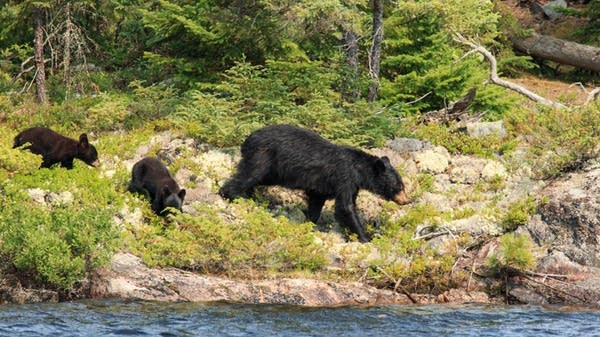A black bear is charging at you. What should you do now?

Black bear attacks in Alaska have left two people dead in as many days.
A 16-year-old boy was killed Sunday during a trail race south of Anchorage. The next day another black bear 300 miles away killed one gold miner and injured another.
In the wake of those attacks, Minnesota DNR bear research biologist Dave Garshelis said Minnesotans have very little to worry about.
Between 12,000 and 15,000 black bears live in Minnesota, but attacks are rare. In all of recorded history, there have been just six bear attacks in Minnesota, and none of them was fatal.
Create a More Connected Minnesota
MPR News is your trusted resource for the news you need. With your support, MPR News brings accessible, courageous journalism and authentic conversation to everyone - free of paywalls and barriers. Your gift makes a difference.
"A human is no match for even a very small bear," Garshelis said. "Luckily, they haven't figured that out. They're still afraid of us."
Nationwide, he said, roughly two people a year are killed by bears. That includes deaths caused by grizzly bears — which are more aggressive than black bears, and don't live in Minnesota.
When a black bear does attack a person, usually it's what Garshelis calls a defensive attack.
"That's when bear is surprised," he said. "Maybe there's a dog barking. Maybe there are cubs involved, and the bear basically lurches out to say 'get out of my space.”
What happened in Alaska, he said, was a predatory attack.
"That's when the bear is looking at a person as a prey item," he said. "It's stalking the person as a food source."
Garshelis has been studying bears for more than 30 years. He's trapped, collared and followed scores of Minnesota black bears. In all that time, he's only dealt with one predatory bear — back in 1987.
Two men in the Boundary Waters Canoe Area Wilderness survived attacks by what they described as a 300-pound black bear. Garshelis was one of a small army of bear experts called in to resolve the situation.
"There were a whole bunch of conservation officers who were flown in," he said. "Everyone was very nervous, we didn't know what we were dealing with."
Officers found and shot the bear. It turned out to be a 90-pound female.
What to do if faced with a charging bear
The odds of being attacked in Minnesota might be slim, but if you do find yourself facing a charging black bear, Garshelis has some tips.
In the moments before a mauling, he said it's very important to understand the bear's motivation.
If the bear is protecting cubs, it's best to back away slowly. Often a defensive bear will charge, but stop short.
"If the bear actually does get on top of a person, that's where you would curl up in a fetal position, put your hands behind your neck and protect your vital organs. If the bear thinks you're dead, it's solved the problem."
On the other hand, if the bear is predatory, curling up in the fetal position doesn't do much good.
"If I noticed a bear was stalking me," he said, "I'd pick up a big stick and a rock. I'd be aggressive. If the bear wants to eat you, obviously you have to fight back."